Voyo V3 Review - A Fanless Intel Atom x7-Z8700 (Cherry Trail) mini-PC
by Ganesh T S on March 1, 2016 8:00 AM EST- Posted in
- Systems
- Intel
- Atom
- Passive Cooling
- Mini-PC
- Cherry Trail
HTPC Credentials
Given the Voyo V3's fanless nature and the presence of Intel HD Graphics, we expect many purchasers to use it as a media playback machine / HTPC. In fact, GearBest markets the Voyo V3 as a media player / mini-PC. It is obvious that we are not looking at a madVR capable machine, but one targeted at the entry-level / average HTPC user or someone looking for a HTPC to put in a second or third room (non-primary HTPC). There are two HTPC aspects that we will explore in this section, one related to network streaming (OTT services), and the other related to local file playback. Prior to that, we have a small sub-section dealing with refresh rate accuracy.
Refresh Rate Accurancy
Starting with Haswell, Intel, AMD and NVIDIA have been on par with respect to display refresh rate accuracy. The most important refresh rate for videophiles is obviously 23.976 Hz (the 23 Hz setting). Bay Trail didn't have problems with this refresh rate, and, as expected, the Cherry Trail-based Voyo V3 has no trouble with refreshing the display appropriately in this setting.
The gallery below presents some of the other refresh rates that we tested out. The first statistic in madVR's OSD indicates the display refresh rate.
Network Streaming Efficiency
Evaluation of OTT playback efficiency was done by playing back our standard YouTube test stream and five minutes from our standard Netflix test title. Using HTML5, the YouTube stream plays back a 1080p H.264 encoding. Since YouTube now defaults to HTML5 for video playback, we have stopped evaluating Adobe Flash acceleration. Note that only NVIDIA exposes GPU and VPU loads separately. Both Intel and AMD bundle the decoder load along with the GPU load. The following two graphs show the power consumption at the wall for playback of the HTML5 stream in Mozilla Firefox (v 44.0.1).
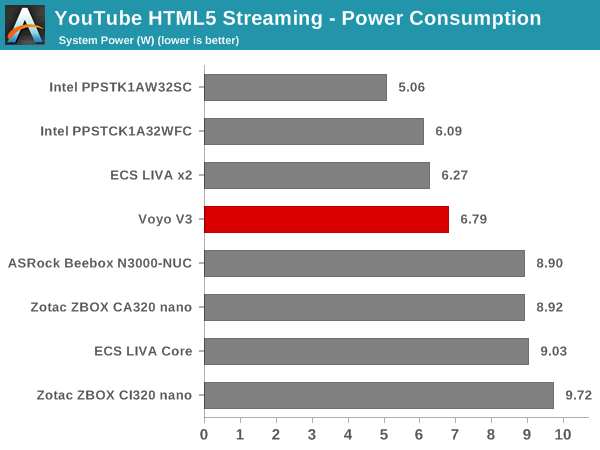
GPU load was around 45.32% for the YouTube HTML5 stream and 5.87% for the steady state 6 Mbps Netflix streaming case.
Netflix streaming evaluation was done using the Windows 10 Netflix app. Manual stream selection is available (Ctrl-Alt-Shift-S) and debug information / statistics can also be viewed (Ctrl-Alt-Shift-D). Statistics collected for the YouTube streaming experiment were also collected here.
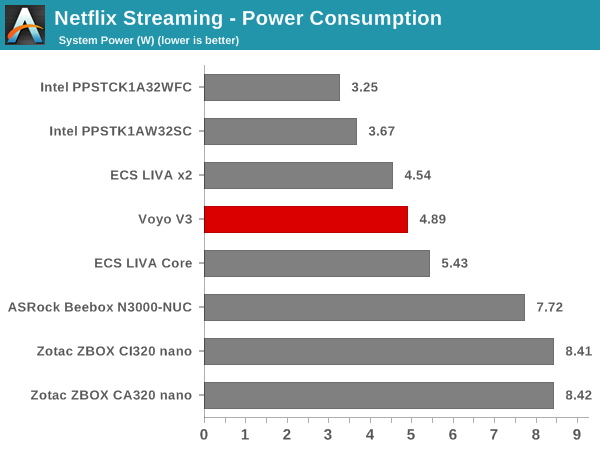
Decoding and Rendering Benchmarks
In order to evaluate local file playback, we concentrate on EVR-CP with MPC-HC and Kodi 16.0. We already know that EVR works quite well even with the Intel IGP for our test streams. In our earlier reviews, we focused on presenting the GPU loading and power consumption at the wall in a table (with problematic streams in bold). Starting with the Broadwell NUC review, we decided to represent the GPU load and power consumption in a graph with dual Y-axes. Nine different test streams of 90 seconds each were played back with a gap of 30 seconds between each of them. The characteristics of each stream are annotated at the bottom of the graph. Note that the GPU usage is graphed in red and needs to be considered against the left axis, while the at-wall power consumption is graphed in green and needs to be considered against the right axis.
Frame drops are evident whenever the GPU load consistently stays above the 85 - 90% mark. The Broadwell-class GPU has no problems at all with any of our test streams (up to 4Kp30 H.264)
Power consumption at the wall was less than 8W even for the most stressful high frame-rate streams. GPU loading was also reasonable (as measured using GPU-Z)
Moving on to the codec support, the Gen8 LP 16 EU-version in the Atom x7-Z8700 is quite similar to that of the Atom x5-Z8300 in the Intel Compute Stick, DXVA Checker serves as a confirmation. The GPU includes decode support for HEVC Main Profile (8b) up to 8K resolution. Unfortunately, without the capability to drive a 4Kp60 display over HDMI, this is not suitable as a 4K HTPC (even though it can drive up to 4Kp30, thanks to the HDMI 1.4b port)









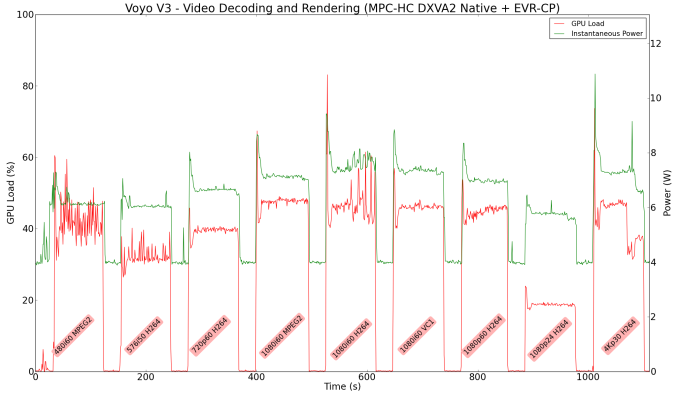
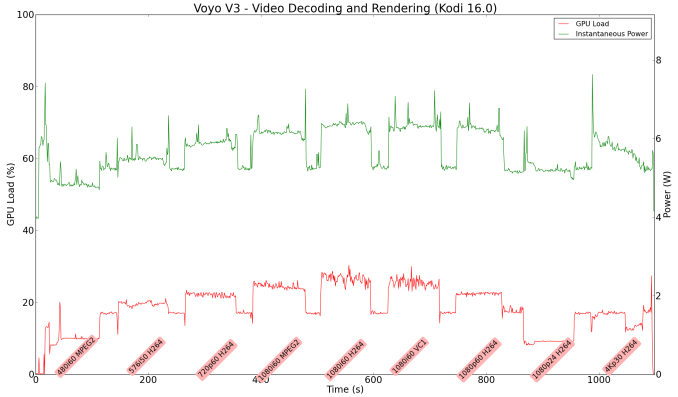
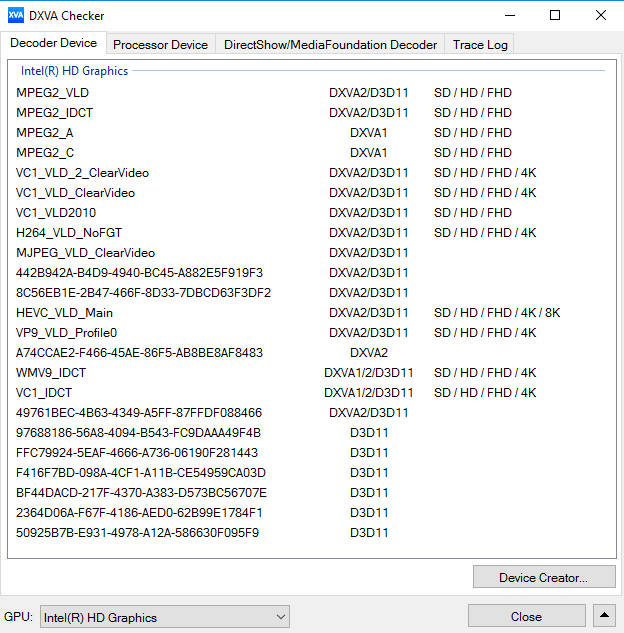








69 Comments
View All Comments
Pissedoffyouth - Tuesday, March 1, 2016 - link
I wish Intel could sort out it's Atom Linux support. Something like this with Linux support would be fantastic. It's been like 3 years and my Asus t100 Baytrail still doesn't work properly 100% without invasive patches for its kernel.BrokenCrayons - Tuesday, March 1, 2016 - link
I've had endless problems getting Linux working on an Asus X205TA that's got a Bay Trail to the point where I've given up on it and it's basically a Windows paperweight sitting in a drawer. HP was a lot better/easier with the Stream 11, but even it isn't as easy as it ought to be to get a proper operating system installed. The hardware specs on these low end Atoms with their passive cooling and low price make them perfect candidates for Linux. I'm not one to spread conspiracy theories, but I think that there's been active work put into the idea of preventing people from easily abandoning Windows on cheaper systems. After all, if Microsoft is giving the OS away for free, they need to recoup their costs through targeted advertising and the Windows Store so the last thing Microsoft would want is the end user population hopping onto an OS where they don't reap any financial return.PsychoPif - Wednesday, March 2, 2016 - link
"I'm not one to spread conspiracy theories, "Except you just did :)
Unless you can provide any shadow of a doubt, I'll keep beliving it has more to do with the fact that Linux is too small of a market to warrant the cost for the hardware maker.
BrokenCrayons - Wednesday, March 2, 2016 - link
I might be mistaken, but the number of computing devices running a Linux kernel is currently higher than those running a Microsoft built kernel. While a lot of that is due to Android, there's also super computer dominance and other fringe markets. Because of Microsoft's recent missteps with Windows 8's user interface and privacy concerns that arose due to Windows 10 telemetry, I think there's a reason for shareholders to be concerned. It didn't take that many years for the Linux kernel to reach a dominant state in the mobile sector. Yes, on desktop and laptop PCs, the market share is about 1.7% running Linux, but that traditional computing model is mature and even in a state of decline as mobile devices running alternative operating systems are apparently taking sales. As handsets have proven, change can happen quickly. It's in Microsoft's best interest, particularly with Secure Boot, to implement mechanisms that help to achieve ecosystem lock-in.Flunk - Tuesday, March 1, 2016 - link
I don't think it's Intel's problem that the Linux kernel has compatibility issues with their hardware. Microsoft initially had some problems with bay trail and cherry trail too, but they fixed their issues. The issues are mostly concerned with certain hardware things these SoCs no longer have that OSes assume x86 chips have. It's not an issue with the hardware.Flunk - Tuesday, March 1, 2016 - link
Also, I should follow this up with the standard open-source argument. If you want bay trail/cherry trail support then you should write it yourself.eek2121 - Thursday, March 3, 2016 - link
I'm not normally one to agree with a troll, but thank you Flunk, as someone who has read that very line across many different open source projects...you made my night. I said this 15 years ago, and i'll say it again. The open source world has 3 problems when it comes to open source adoption. The biggest one is the asshole community. Fix that issue and you'll go a long way towards widespread open source adoption. Unfortunately, there is no shortage of assholes out there...so good luck!sprockkets - Tuesday, March 1, 2016 - link
I'm on such a cpu right now, the Pentium 3700. About the only issues with Linux are video, and the drivers for it are from Intel, open source as well.What is weirder is that video wise, Android works way better than typical Linux. Probably because it doesn't use X. I'd look into Remix OS or the Android x86 project. Best part of the latter is you'll have no issue with updates or upgrades vs the typical android tablet.
extide - Wednesday, March 2, 2016 - link
No, it is an issue with Intel because they should be submitting the patches and drivers to make stuff work properly.Camikazi - Wednesday, March 2, 2016 - link
But it's Linux, if it doesn't work you can fix it yourself, isn't that the big thing about it? I don't think Intel should submit anything to make it work, they do it if they can and if they want to other than that you are on your own making it work.